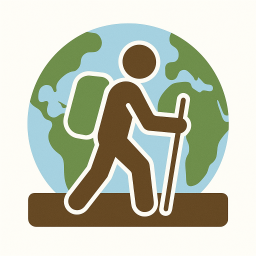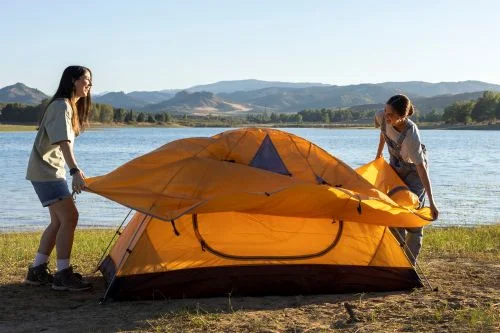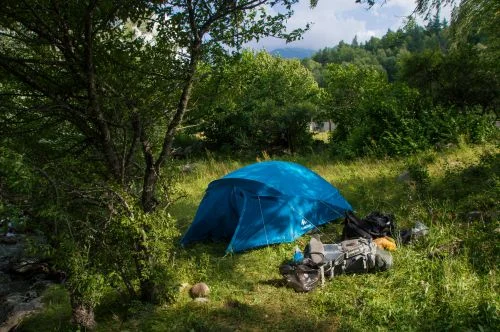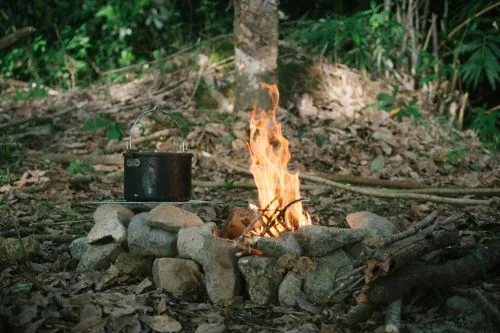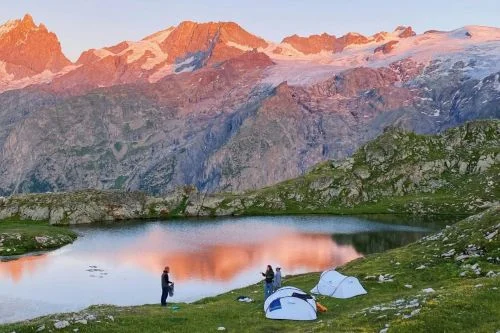
Wild Camping in France: where and how to sleep outdoors
Where can you legally wild camp in France?
Sleeping under the stars, pitching a small tent in the middle of wild scenery, that’s what attracts so many hikers and outdoor lovers. But in France, wild camping isn’t “free” everywhere. It’s subject to rules, local regulations, protected areas, and sometimes strict bans.
This guide explains the key points, from national legislation to exceptions in French national parks, so you know exactly where and how you can legally camp overnight in the wild.
Understanding the difference: bivouac vs wild camping
First, it’s important to distinguish two terms often confused: bivouac and wild camping. French law tends to treat them differently: bivouacking is often tolerated under conditions, while wild camping is frequently banned.
A bivouac is a minimalist, one-night stop during a hike, with light gear — compact tent, tarp, sleeping bag — and no permanent or bulky structures. You set up camp in the evening, break it down in the morning, and leave no trace. This obviously means minimizing your environmental impact. For food: plan simple, lightweight meals (freeze-dried dishes, noodles, couscous, energy bars) to reduce packaging and leftovers; use a safe portable stove (gas or solid alcohol) on mineral ground and avoid open fires; pack out all waste — packaging, peels, scraps — in sealed bags to avoid smells and protect wildlife. For personal hygiene, use biodegradable wipes or a small damp cloth with neutral or outdoor soap, always far from water sources (at least 50 to 70 meters). For natural needs, move away from streams (minimum 70 m from springs or brooks), dig a small 15–20 cm hole, cover carefully, and carry used toilet paper back out in a closed bag. When setting up your sleeping spot, do not alter the site: protect vegetation, no digging trenches or moving stones, and if you really must adjust for wind protection, restore the place before leaving.
Wild camping, on the other hand, usually means staying several nights with more permanent installations — bigger tents, tables, coolers, heavier stoves for cooking, solar showers, basins for washing, inflatable mattresses for sleeping. It often implies bringing gear by vehicle — bike, motorcycle, or car — and camping closer to roads or accessible areas.
At the legal level, texts such as the Decree No. 2015-1783 of 28 December 2015 specify the provisions of the Urban Planning Code concerning wild camping and land use. However, the exact rules vary greatly between municipalities, national parks, protected areas, and local bylaws.
Thus, to say “bivouacking is legal” everywhere would be too simplistic: it is allowed where it is not forbidden, subject to respecting local constraints.
General principles and common prohibitions
To know where to put your tent, here are some principles and prohibitions generally applicable across France:
- It is forbidden to camp in the urban areas, on the Public roads, as well as in municipal parks, unless expressly authorized.
- Bivouac is prohibited in urban areas, except specific authorization given by the town hall or the field manager (sporting event, festival, organized hike). In general, it is tolerated in natural areas outside urban areas where it is not expressly prohibited.
- It is generally forbidden to bivouac unless 200 meters of a drinking water catchment, to avoid any contamination.
- Bivouac is often forbidden in classified or registered sites, nature protection areas, nature reserves or heritage areas.
- We frequently find prohibitions unless 500 meters from a historic monument or from a classified site.
- Campfires are in most cases forbidden, especially during periods of drought or in sensitive areas. Parks require the use of stoves only.
- Some parks or municipalities impose schedules: installation after the evening (around 19:00 or 20:00), dismantling before morning (around 9:00).
- You often have to be away from at least An hour's walk park boundaries, roads or motorized accesses, to prove that you are roaming and not camping.
- Some parks absolutely prohibit bivouacking: among the best known, the Calanques National Park or Port-Cros.
These principles form a basis for vigilance. But what's allowed in one park may be forbidden in another, depending on local ordinances. Hence the importance of consulting official websites or tourist offices before going bivouacking.
Special cases: national parks and protected areas
French national parks are particularly demanding. The regulations are often more stringent in Heart of the park, while theMembership area (peripheral zone made up of municipalities that have voluntarily chosen to adhere to the park charter) can offer more flexibility.
Here are some typical examples to remember:
- Écrins National Park : bivouacking is authorized between 7 p.m. and 9 a.m., in a light tent (not allowing standing), and more than an hour's walk from road accesses or park boundaries.
https://www.ecrins-parcnational.fr/bivouac
- Mercantour National Park : same time constraints (19h—9), minimum walking distance of one hour, exclusive use of light tents, ban on fires.
https://www.mercantour-parcnational.fr/fr/le-parc-national-du-mercantour/la-reglementation
- Pyrenees National Park : bivouacking is authorized from 7 p.m. to 9 a.m., provided you walk at least one hour away from any road or park boundary.
- Cevennes National Park : the practice is allowed under conditions on or near marked routes (GR/GRP), on a restricted strip (often 50 meters on either side of the trail), for a single night, from 19:00 to 9:00am, and with light tents. However, some portions are not allowed.
- Vanoise National Park : camping is strictly forbidden, but a restricted bivouac is tolerated only in areas dedicated to refuges during guarding periods, with possible remuneration.
Note that park regulations are changing: it is essential to check the official documents of the park concerned just before you leave.
Regional natural areas, reserves and less protected areas
Outside of the national parks, you'll find regional natural parks, of nature reserves, of forest areas, intercommunal or private land. Again, the rules vary greatly depending on local management:
- In many regional natural parks, bivouacking is tolerated, often with more flexible conditions than in national parks. But some sectors may be subject to specific prohibitions (summer regulations, fire, tourist traffic).
- In some nature reserves, bivouacking may be prohibited or limited to defined areas. It is imperative to consult prefectural orders or specific regulations.
- On private land, bivouacking is possible with the explicit agreement of the owner. This is still the safest solution in areas with few restrictions.
- In an unprotected area, provided that no municipal decree prohibits it, bivouacking can be tolerated according to general principles (respect for the environment, reasonable hours).
When possible, before each outing, consult the City hall website, municipal or prefectural orders, or even local tourist offices, to find out if a sector is open or closed at the bivouac that day.
Practical advice for bivouacking legally and respectfully
To maximize your chances of bivouacking legally and safely, here are some recommendations based on experience:
- Plan your itinerary in advance : identify protected areas, national parks crossed, and look for local ordinances.
- Arrive late (around nightfall) and Leave early in the morning: do not set up in broad daylight, and dismantle before dawn.
- Stay discreet : choose isolated locations, a bit back from the path, avoid very visible edges, clearings that are too open, or the outskirts of villages.
- Use a lightweight tent, with a weak grip, and avoid models in which you can stand. This often corresponds to park requirements.
- Avoid fire unless clearly authorized, and prefer portable stoves. In summer, in dry areas, the use of fire is frequently prohibited.
- Be flexible : if you discover a prohibition sign on site, leave without talking.
- In the national park zone: respect the minimum access distances (timetables, walking distance of one hour) and consult the specific regulations of the park in question.
- If you have the option, Ask the town halls or owners to obtain prior authorization, especially in less documented areas.
In summary, the legislation concerning the authorization or not of bivouacs is complex and diverse. To enjoy unforgettable nights under the stars, in nature, while remaining legal and respectful of the natural environment, this requires:
- To understand the distinction between bivouac and wild camping, and to respect the minimalist spirit of bivouac.
- To know the general principles (distances, schedules, forbidden, respect for the environment).
- To consult local regulations, municipal by-laws or those of the parks crossed.
- To be discreet, light, autonomous and respectful.
- To remain flexible and ready to change plans if the chosen location is forbidden.
